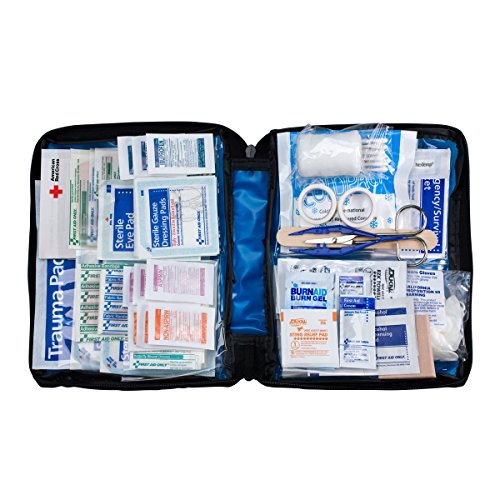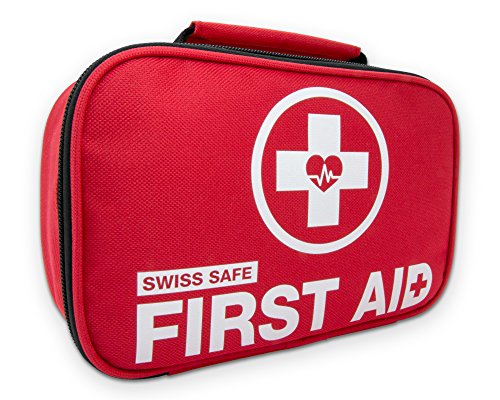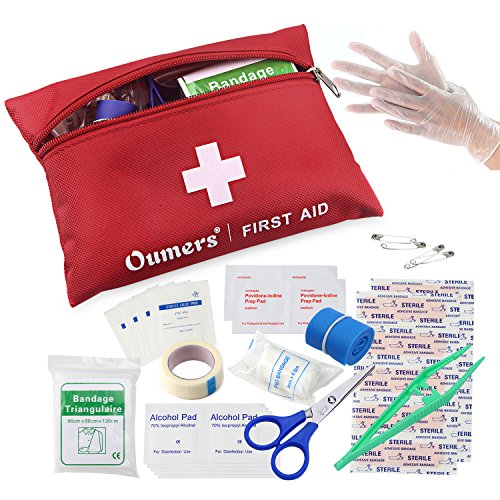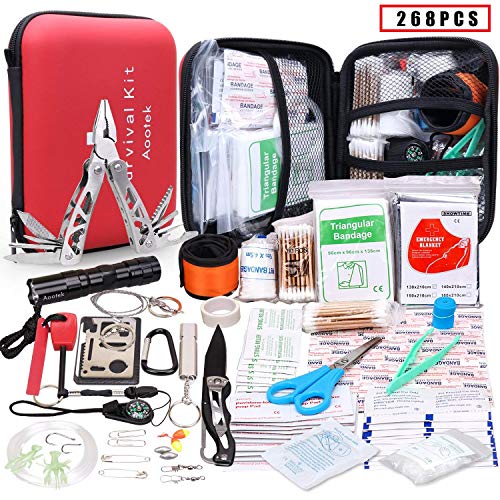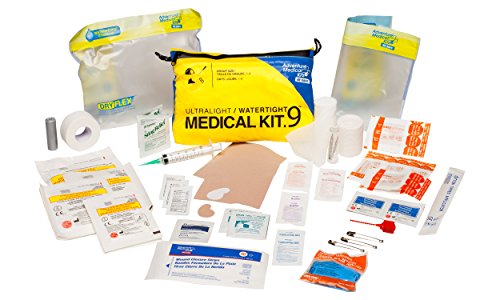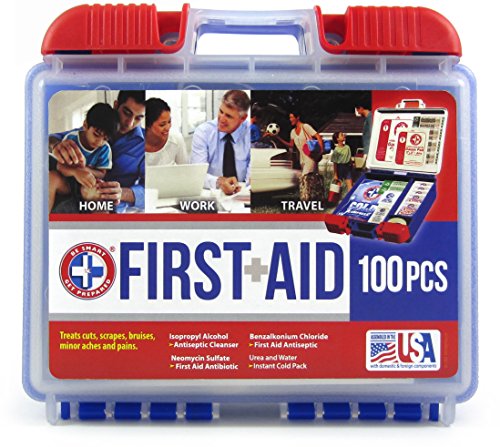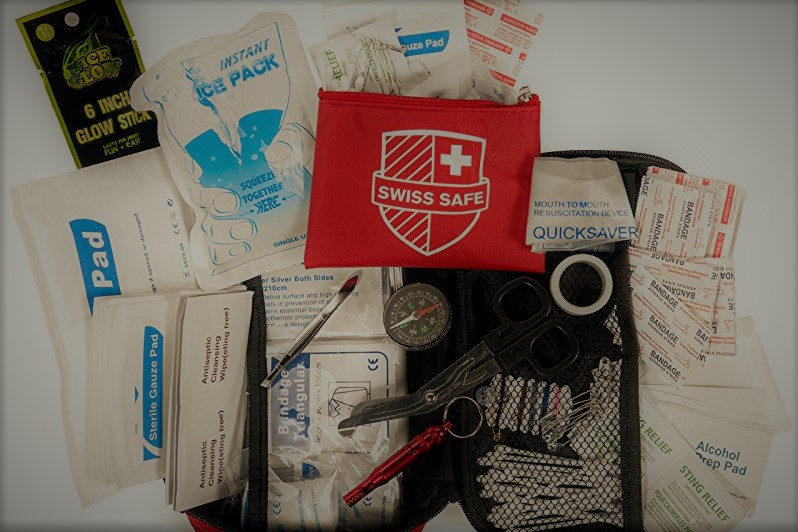
As a new hiker, we’re usually focused on gear, weight, colors, technical specs, etc. Some of the broader concepts tend to get lost in the details. Such as, “Hey, what will I do if I get a big infected blister?”. That’s when it hits you – you forgot to pay attention to your hiking first aid kit!
More...
As a seasoned backpacking guide and (once) certified Wilderness Emergency Medical Technician, I can’t even tell you how often I’ve had to fall back on a well-stocked first aid kit. By far the most common injury I see is a blister.
After that, common injuries include all manner of athletic sprains and strains, hot water injuries from cooking, and digestive issues from one source or another. If you’re not ready for these occurrences they’ll take you, or your partner, off the trail in a hurry.
By the time you’re done reading this article, you’ll have a better understanding of what to look for in a backpacking first aid kit. I’ll toss in a few common mistakes to be sure to avoid and follow it all up with a handful of hiking first aid kits you can choose from if you’re looking. After that, you’re on your own to enjoy the great outdoors and make it back to the trailhead safely!
Comparison Chart
Name | Price | Weight | Rating | Notes |
|---|---|---|---|---|
$$$ | 1.2 lbs | Contains 299 physician-recommended supplies | ||
$$$ | 1.1 lbs | 120 Piece First Aid Kit | ||
$$$ | 2.56 oz | Great Emergency Kit for most daily use or adventures, Ideal for homes, offices, camping, cars, restaurants, autos, sports, boats, road trips, workplace, schools and other emergency rescue, several different aid kit products to handle trauma situations | ||
$$$ | 4 oz | Recommended Use: Day hikes, camping, backpacking | ||
$$$ | 0.8 oz | "The Little Champ" is so light weight you'll hardly know you're carrying it with you. | ||
$$$ | 7.4 oz | Unique And Upgraded items - based on customers' feedback.Bigger, stronger metal scissors and knife. inside is everything you need to help you survive: fire starter, knife, compass, whistle, saw, multipurpose flash light pliers,scissrs,flashlight,fishing lines,fishing weights,fishing | ||
$$$ | 12.8 oz | Manage injury and ailments for 1-5 people on short trips with this first aid kit designed for basecamp or backpack duty. | ||
$$$ | 7.2 oz | Perfect for athletes refusing to be hampered by his or her gear's weight, this kit has been tested, abused, and approved by adventure racers in the Eco Challenge, Primal Quest, and Raid Gauloises. | ||
$$$ | 1.1 lbs | The KIT bag is water resistant, durable with strong zips and double stitched handles. There are belt loops and the bag has reflective piping to help you find the KIT in the dark. | ||
$$$ | 11.2 oz | This Kit meets United States FDA Regulatory Standards as a Medical Device. Ideal for most businesses and perfect for family use at home or travel. |
5 Tips to Choose the Best Backpacking First Aid Kit
So, what have I learned over the years?
There are a few key things to look for and a few pitfalls to avoid. Beyond that, the contents of your hiking first aid kit should reflect your level of knowledge and proficiency in emergency medicine as well as the unique situations you expect to encounter on each hike.
Be careful listening to the opinions of Joe Schmoe on the forum boards. Instead, seek the advice of real wilderness medicine experts when looking for answers.
Bigger Isn’t Always Better
There are two ways you can make a mistake in this part. Some hikers put every possible medical tool into their first aid kits. This is a mistake.
Some hikers try to go without a first aid kit, or with a kit that isn’t sufficiently stocked. This, also, is a mistake.
Yeah, you’re going to have to tread a very fine line between overstocked and under-stocked. Let me put this into perspective. When I hike alone I carry a smaller first aid kit. I know the likely problems I’ll encounter are fewer and within a narrower band of probability.
When I hike with big groups I carry a much larger kit because I could be called on to respond to a nearly unlimited number of trauma or medical emergencies for the group.
Use It Or Lose It
Avoid including items in your first aid kit that you’re not familiar with. Either learn how to use the items (butterfly closures, irrigation syringes, etc.) or ditch them. They won’t do you or anyone else any good if you open that fancy new first aid kit just to realize you don’t actually know how to use the sphygmomanometer.
It’s good practice to open your first aid kit as soon as you get it to familiarize yourself with the contents and their location in the kit. If you’re unsure of how to use something, be sure to look up a video or ask a professional. Then actually practice using it. Triangle bandages do make great slings, but if you’ve never practiced tying them you’ll likely do more harm than good.
Pack for the Likely Scenarios
I will tell you that 95% of the times I open my med kit it’s for blisters on other people. I don’t get blisters often but dealing with blisters on hikers in my group seems to consume nearly all of my time in the med kit. Learn how to properly clean and dress a blister – I’ve seen crippling infection set in on blisters that are improperly treated.
After blister treatment, good old ibuprofen and NSAIDs are the next most used item. Benadryl is another common one that gets used a ton. Pack tons of roller gauze, 4x4s, and antiseptic cream of your choice.
Honestly, if you’re prepared to deal with the above-mentioned situations you’ll be ready for 95% of trail problems. Of course, there’s always the unlikely but entirely possible major injury or critical medical situation that can’t be predicted but are all too real.
Restock Your Kit
This seems like a simple one, but it’s a crippling mistake. After each trip, be sure to note what got used and replace any contents. Nothing sucks like running out of antiseptic halfway through a trip because you forgot to restock.
If you’re thru-hiking make sure you restock at each stop or you’ll find yourself quickly running out. If supplies are hard to find, just mail yourself a few packs of the common stuff – gauze, antiseptic, ibuprofen, etc.
If you bother to keep records long enough, you’ll eventually start to note patterns. After a year or two of hiking, you’ll have a record of what you normally use. This way you can tailor your kit over the years to your liking. Just be careful about leaving stuff out in case you do need it someday down the road…
Consider Building it Yourself
If you have specific needs or enough training to understand what contents you’ll want in your kit, then make the kit yourself. Use a ziplock bag, stuff sack, or buy an empty medical kit. Then selectively fill it with the contents you want or need so you don’t end up with a bunch of crap that won’t ever get used.
Don’t forget the tweezers!

Hiking First Aid Kit Reviews
When it comes to first aid kit, I’ve yet to meet one that doesn’t need to be modified out of the box. However, these first aid kits are a decent place to get started and tailor to your desires as you go!
What We Like
Of all the kits on our list, this one is my top pick. I even carried a heavily modified version of it myself for a summer on the Appalachian Trail. So what makes this one stand out above the others?
They actually packed it with an appropriate amount of the right items! It lifts my heart to see a first aid kit that’s packed well.
They included 14 alcohol pads, 15 antiseptic wipes, and 6 antibiotic packs. These are critical blister treatment items and should last one or two people several weeks of hiking (unless you’re unusually prone to blisters). If you’re hiking with a larger group of 6+ it might last you a week of backpacking if you’re lucky.
What We Don't Like
One thing I don’t like is that they chose to include 50 “junior bandages” (small band-aids). Who needs 50 tiny band aids??? Please, tone down the mini band-aids and instead give us more ibuprofen which they only chose to include 6 tablets of. You’ll definitely want to add more ibuprofen!
Also, the plastic tweezers are a huge letdown. I wish they would charge us more for the kit and replace it with a useful metal pair of tweezers. If you’ve never tried to fish out tiny splinters in the woods with plastic tweezers, let me tell you… you’ll be in for a frustrating experience.
Ultimately this hiking first aid kit will serve but I think you’ll find it lacks in some areas and is overstocked in others. Like all hiking first aid kits, I would encourage you to modify it to your needs.
What We Like
Depending on exactly what your needs are, this med kit might actually be as good or better for many hikers than the first one we reviewed. I like that there’s a reasonable number of band aids!
For most individual or partner backpacking trips it probably won’t be necessary to carry all 1.2 pounds of first aid equipment in this case. Some will choose to carry everything but the kitchen sink, others may want to pare it down.
What We Don't Like
One thing to watch out for is the low number of antiseptic gels and prep pads. Prep pads get used like candy for cleaning and sterilizing before working on a blister, dressing a wound, or practically any other work. You can never have too many of those suckers so add a few extra to this kit if you purchase it.
This is the perfect kit to start with and then begin modifying to your needs. The fabric carrying case makes for a nicely self-contained package that you can grab and go anytime.
What We Like
For those of you in the lightweight or ultralight category of hiking, this one is right up your alley. Truthfully if you want the lightest weight med kit, you’ll have to make it yourself from scratch. Don’t trust yourself to make a medkit from scratch? Then consider the Oumers First Aid kit.
I love the tiny package and lightweight contents for hiking and backpacking. I personally carry a med kit of about 1.5 ounces, so this one’s right up my alley. The 10 pcs alcohol pads are nice for killing germs before you lance a blister.
What We Don't Like
You’ll want to add ibuprofen because let’s face it, we can never have too much on the trail. The surgical tape is perfect for custom made bandages and band-aids when paired with the roller gauze.
One major oversight is antibiotic ointment and moleskin. However, this kit wasn’t *technically* made for hiking so you’ll want to add those in yourself. At just 2.6 ounces you’ll end up with a decent kit overall at probably ~4 ounces.
What We Like
If you’re a lightweight hiker and you’re not interested in modifying your first aid kit, the Lifeline Trail Light could be the kit for you. It’ll cost you a bit more up front than the Oumers kit, and you’ll still have to modify it. However, it does have a more ideal set of first aid contents.
Sting relief pads, antibiotic ointment, gauze pads, and tape are all included and absolutely necessary for standard trail maintenance.
Overall I think this is a good starting point for an ultralight medical kit for backpacking but it’s not perfect…
What We Don't Like
While the tweezers are metal, the moleskin will need to be upgraded to be sufficient.
There are a few ibuprofen pills, acetaminophen, and antihistamine pills but you’ll definitely want to add more. There are only two of each type and if you’ve ever been hiking on long trips you’ll know that two packets are just not going to cut it.
What We Like
This one is a bit unconventional. But, paired with some of the lightweight kits above, could really round out a first aid kit for backpacking. It is unbelievably small, which is nice. To achieve that they’ve mostly stocked the kit with wipes, packets of medicine, and band-aids. Why? Because they’re all super small and flexible and that way they can compress.
While it’s a total of 5 ounces overall, it’s packed to the hilt with things like band-aids, burn cream, and alcohol prep pads.
What We Don't Like
It won’t make a great comprehensive first aid kit, but it does have prep pads, ointment, and medicine you may need on the trail. For most people, the Lifeline kit combined with this kit will be more than enough to cover any normal situations.
I don’t like that it really has to be combined with another kit in order to be effective, but all said and done it makes a very compelling 1-2 punch if you’re willing to carry both.
As a note, this might make a decent day hiking kit and a perfect supplement to a longer backpacking first aid kit.
What We Like
If you’re a survivalist at heart and need to fill out the roles of both med kit and survival kit, look no further.
Typically I prefer to keep my med kit as just that – a medical kit. However, I know many newer hikers are lacking both medical supplies and survival gear. That’s why I think this kit might appeal to many of you.
According to my best research, it looks like this kit will weigh in at about 7.5 ounces which is really impressive when you consider that it has some heavy stuff like:
- Multi-Tool
- Knife
- LED Flashlight
- Tons of medical supplies
What We Don't Like
Where I worry this kit comes up short, however, is in real hiking medical supplies. There are band-aids, sting relief, triangle bandages, and more. But it lacks the basics like moleskin, sanitizing prep pads, and antiseptic ointment.
Overall this kit makes sense as a basic survival kit with basic medical supplies all wrapped into one but I’d recommend beefing up the medical side of it for hiking specifically.
What We Like
Adventure Medical Kits actually tends to put out some pretty well-focused wilderness medical solutions. That said, it might not be perfect but it’s a step in the right direction.
To start with, I love that this kit comes with several pre-shaped pieces of moleskin. Advanced hikers probably prefer to cut their own but newbies will be well-served by using pre-cut shapes to get started.
If anything it’s a bit light on contents but over time you’ll learn more about what you, as an individual hiker, need in your kit.
What We Don't Like
I think most hikers will want to add a few more alcohol prep pads, ibuprofen, and antibiotic ointment. Outside of that, however, there’s just enough of the rest to take care of minor injuries and incidents for a large majority of likely hiking injuries.
If you want to cover larger trauma possibilities, add a few more 4×4’s and a couple roller gauze and you should be good for just about anything you can reasonably expect to handle in the woods.
What We Like
This is probably a good comparable to the #1 kit in our list, the 299 piece kit by First Aid Only.
The main differences between the two are size and scope. This kit is a little more narrow and focused but it has everything you need to deal with most likely trauma situations in the field and many medical situations.
Another major difference between this kit and the others on our list is that it comes with water “resistant” bags which are probably as close to waterproof as you’re going to get. Of course, it’s pretty easy to make any medkit waterproof with a few Ziploc bags but these waterproof DryFlex bags are much more durable than a standard freezer bag.
What We Don't Like
Again, my most common complaint is that there aren’t enough blister supplies like antiseptic ointment, moleskin, and prep pads but you can add more yourself.
What We Like
Do you feel like maybe you’re not an expert with medical supplies? You’re not 100% certain what the difference is between a triangle bandage, 4×4, or trauma pad? Don’t worry, most people aren’t trained in emergency medicine and even those of us who are could use a refresher once in a while.
That’s the reason this med kit gets a shining endorsement from me. I think it’s ingenious that they labeled all of the pockets with the relevant topic. These are the categories of supplies:
- Shears
- Tape
- Minor Wounds
- Wound Closure
- Wound Cleaning
- Sling, Pressure, Head Bandage
- Wounds, Sprains, Snake Bites
Of course, you could always buy a different medical kit and simply organize contents into similar categories with individual bags or labels as well. Maybe there’s a lesson to be learned here!
What We Don't Like
As always my biggest beef is that the numbers are lacking. On a week-long hiking trip with a couple headaches, an aching knee, and a dozen blisters you’ll probably be long-since out of vital supplies.
Normally I hate hard sided objects in a backpack. They’re difficult to pack and hard to get comfortable.
What We Like
In this case, however, I think a hard-sided case might have some advantages. Assuming you pack it into your backpack properly so that it’s comfortable, the hard-sided case can help prevent contents from getting smashed or broken in the pack.
Usually, the only things I’d worry about getting smash are things like pills in single-use packets, popsicle sticks, irrigation syringes, and other delicate medical components. For that reason, you could consider using any soft sided med kit and instead just use a small canister to protect the “crushable” if you don’t want a big box in your backpack.
When it comes to kit contents I do like the disposable chemical ice pack in this kit which is rather rare in hiking specific kits. It also has more prep pads than most but…
What We Don't Like
I think overall it lacks blister treatment options and ibuprofen for starters. You could easily ditch a few of the band-aids and replace them with a minimalist med kit like the Oumers we reviewed earlier on this list to round out this kit’s ability on the trail.
How to Improve Your Med Kit
In most of these reviews, you’ve seen me mention a lack of blister treatments and a few other common items. Here I’ll outline a few supplies you’ll probably need to replace or improve in most medkits and where to find them.
Conclusion
First aid kits must be tailored to the length of your trip and the number of people in the party. Remember that your level of knowledge and skill, to some extent, predicates what you will choose to include in any given first aid kit. What is the best hiking first aid kit? Frankly, that completely hinges on where you’re hiking and what you expect to need.
In my opinion, all first aid kits need to be modified or at the very least must be restocked at some point. In order to do this, you’ll have to be somewhat proficient with your medical kit’s contents.
Consider getting some wilderness medicine training and you’ll be glad you did!

